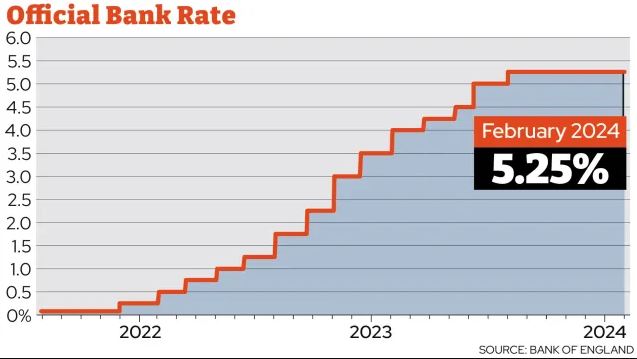Bank of England holds rate at 5.25 to mark a 16-year high. Although analysts presumed a cut, the Monetary Policy Committee voted to retain the base rate. Governor Andrew Bailey emphasized the importance of combating the high inflation rate in the UK.
Bank of England Holds Rate Overview
The Monetary Policy Committee’s 7-2 vote signals a commitment to combating the 6% UK inflation. Governor Bailey clarified the importance of forthcoming data to ensure the committee assesses UK inflation accurately. In any case, the Bank of England holds rate amid a significant decline in the April headline inflation to potentially less than 2%.
The Governor cautioned against premature rate cuts that would instead hamper the UK economic recovery. Thus, the Bank of England interest rate decision differed from other central banks like the European Central Bank. These banks signaled readiness for cuts.
Reasons Why Bank of England Held Rate
The Bank of England held the rate at 5.25% despite expectations for a cut. Factors influencing the decision included UK inflation rate, economic growth prediction, global political tensions, and overall data considerations.
- Data Considerations
Overall, the Bank of England held rate after a comprehensive data assessment of wage growth and the consumer price index. The data gives the Monetary Policy Committee insights into the economic outlook and UK inflation risks. In general, Governor Bailey's statement clarified that the data will also determine the next decision on June 20th.
- Global & Political Context

The UK general election is fast approaching, and the ruling Consecutive Party aims to maintain economic credibility and manage UK inflation rate. Simply put, they have a mandate to manage UK inflation rate, which poses polling challenges. In the meantime, the UK economy faces pressure from global dynamics, such as US inflation impacts.
- Economic Growth
Despite the modest growth of 0.4% in the first quarter & 0.2% in the second quarter, the UK economic growth has lingering concerns. Thus, the Monetary Policy Committee called for closely monitoring all economic indicators. Factors like volatile energy markets and geopolitical tensions raise the inflation rate in UK.
Bank of England Holds Rate Aftermath
Economic outlooks and market sentiments have recorded varied responses after the Bank of England held rate. Investors and analysts look forward to the forthcoming data to determine the monetary policy trajectory. Here are more insights:
- US Policy Difference
The US Federal Reserve will likely hold rates longer than the Bank of England. Overall, the Fed is struggling with different inflationary and economic pressures. The US inflation rose to 3.5% in March, highlighting distinct economic conditions among the two countries. Meanwhile, the UK might initiate a rate cut in the next reading.
- Market Sentiments
Financial markets are grappling with mixed reactions of caution and anticipation. Although the Bank of England held rates to align with analysts’ expectations, some are concerned about the cuts' timing. Recent market pricing analysis indicates that the first-rate cut would be in June, sparking stock earning rise return.
Wrapping Up!
Overall, the Bank of England holds the rate at 5.25% to ensure vigilance over inflation rate in the UK. United Kingdom policy makers remain wary that early rate cuts might harm the UK economy without immigration. Yet, the Bank of England and the US Federal Reserve are at different stages of controlling the inflation rate in the UK.





